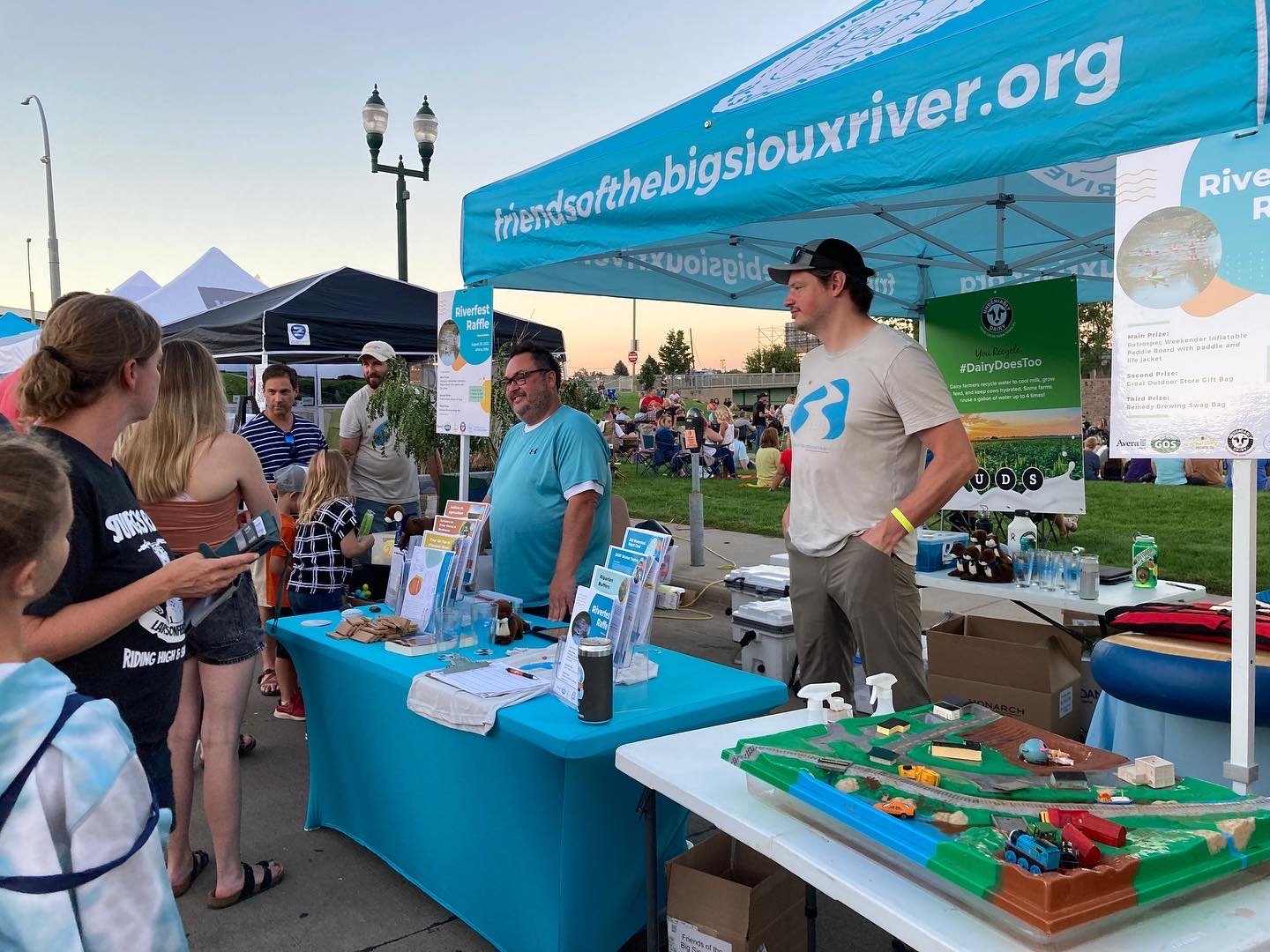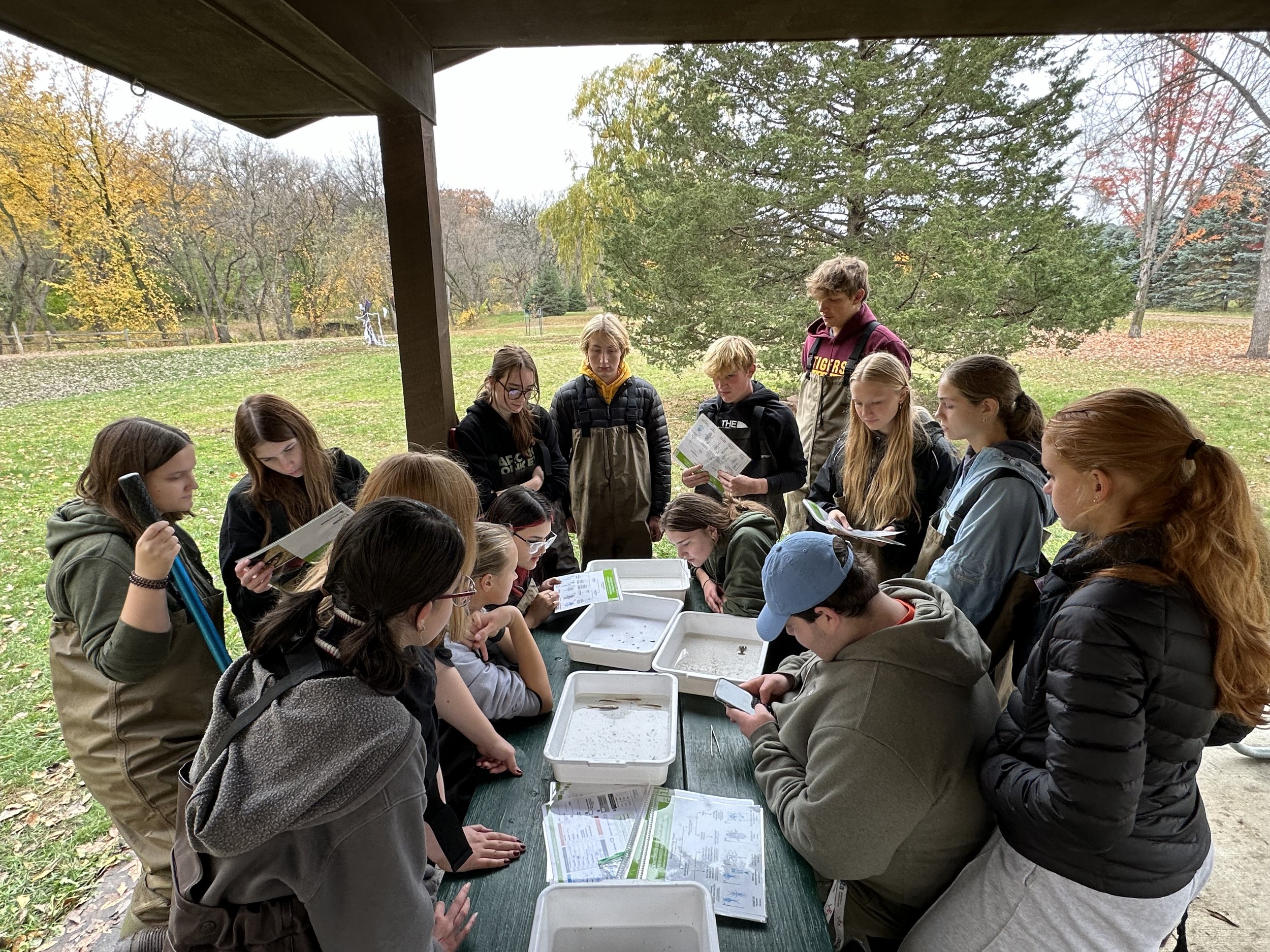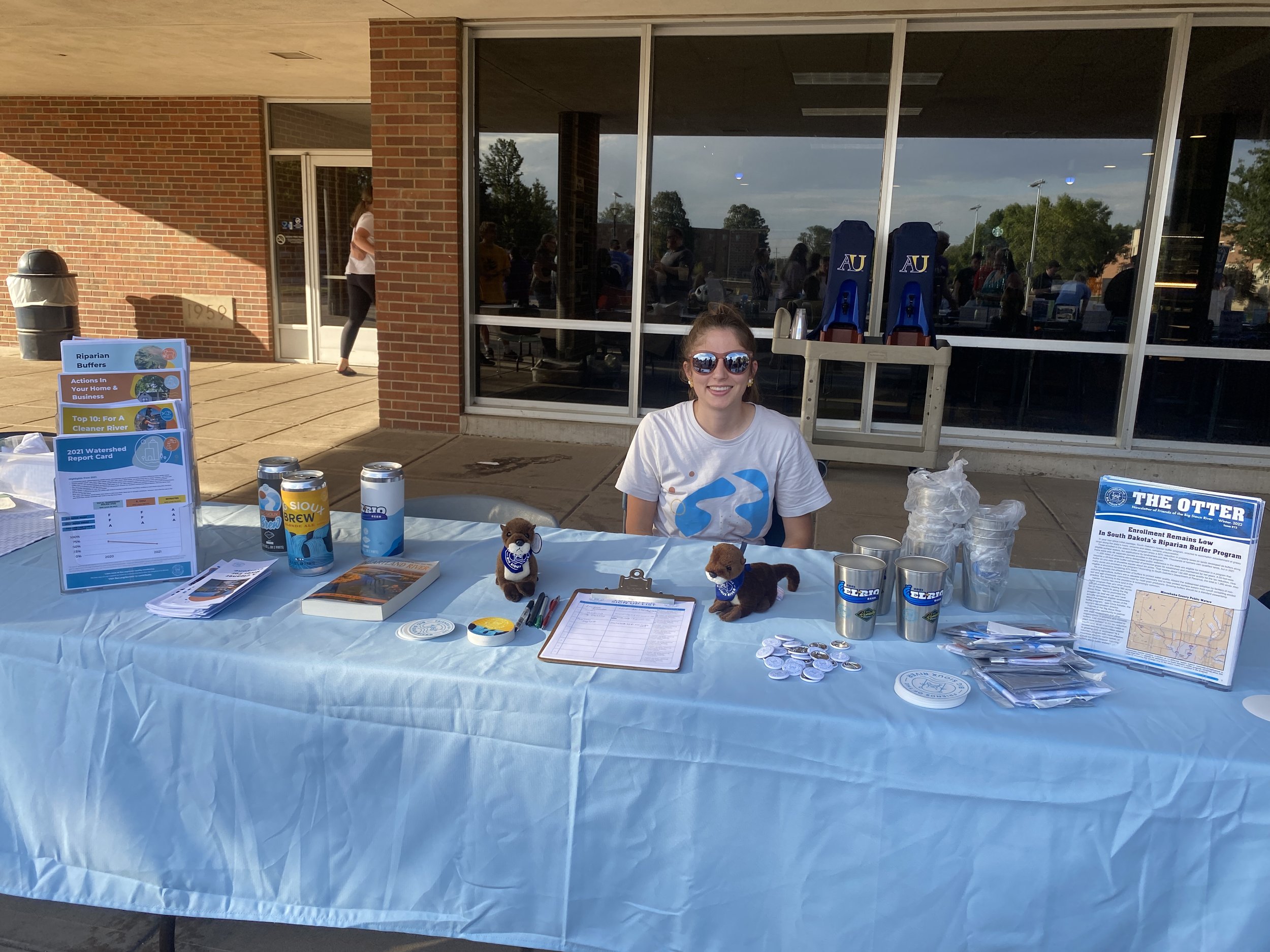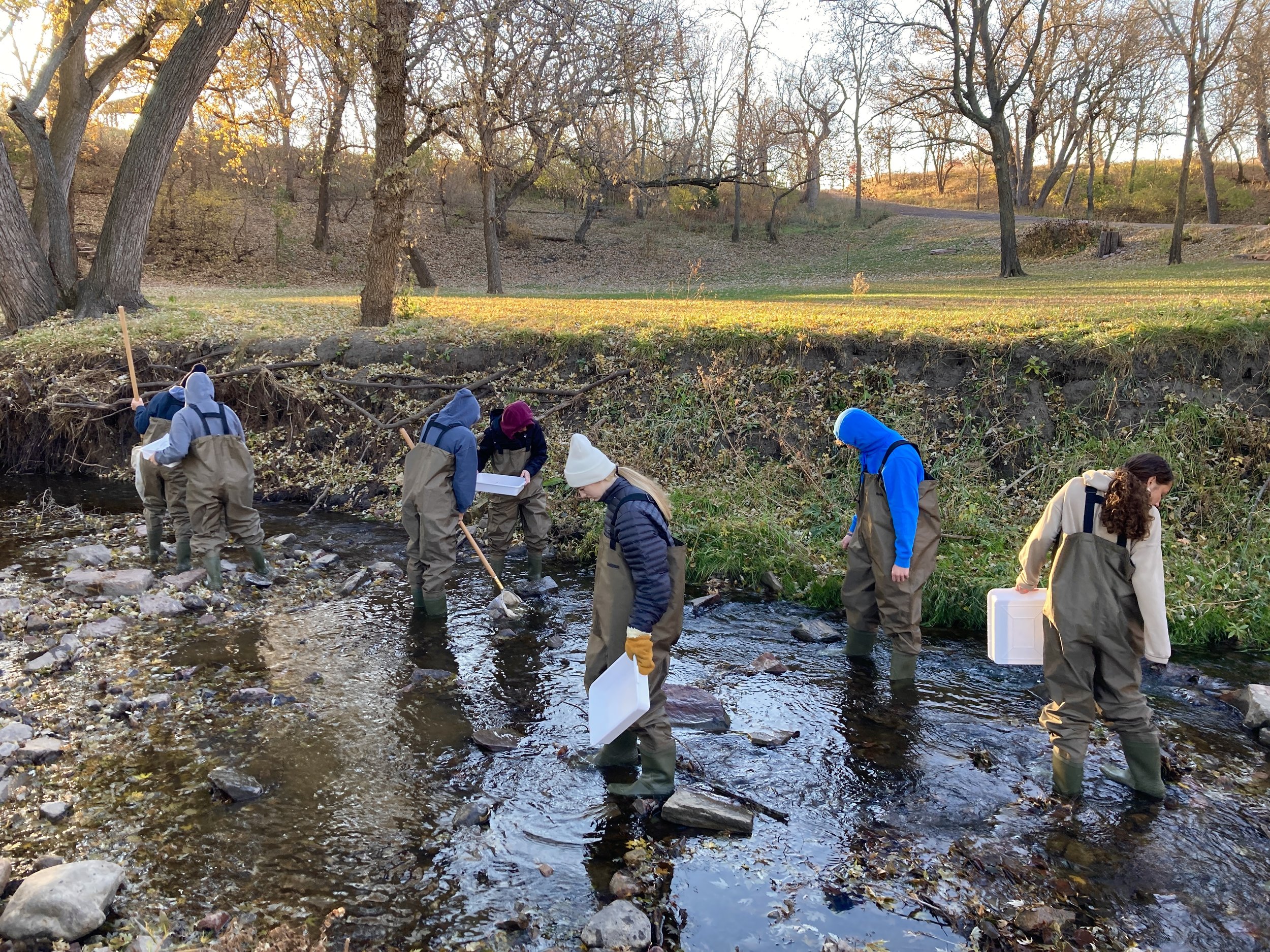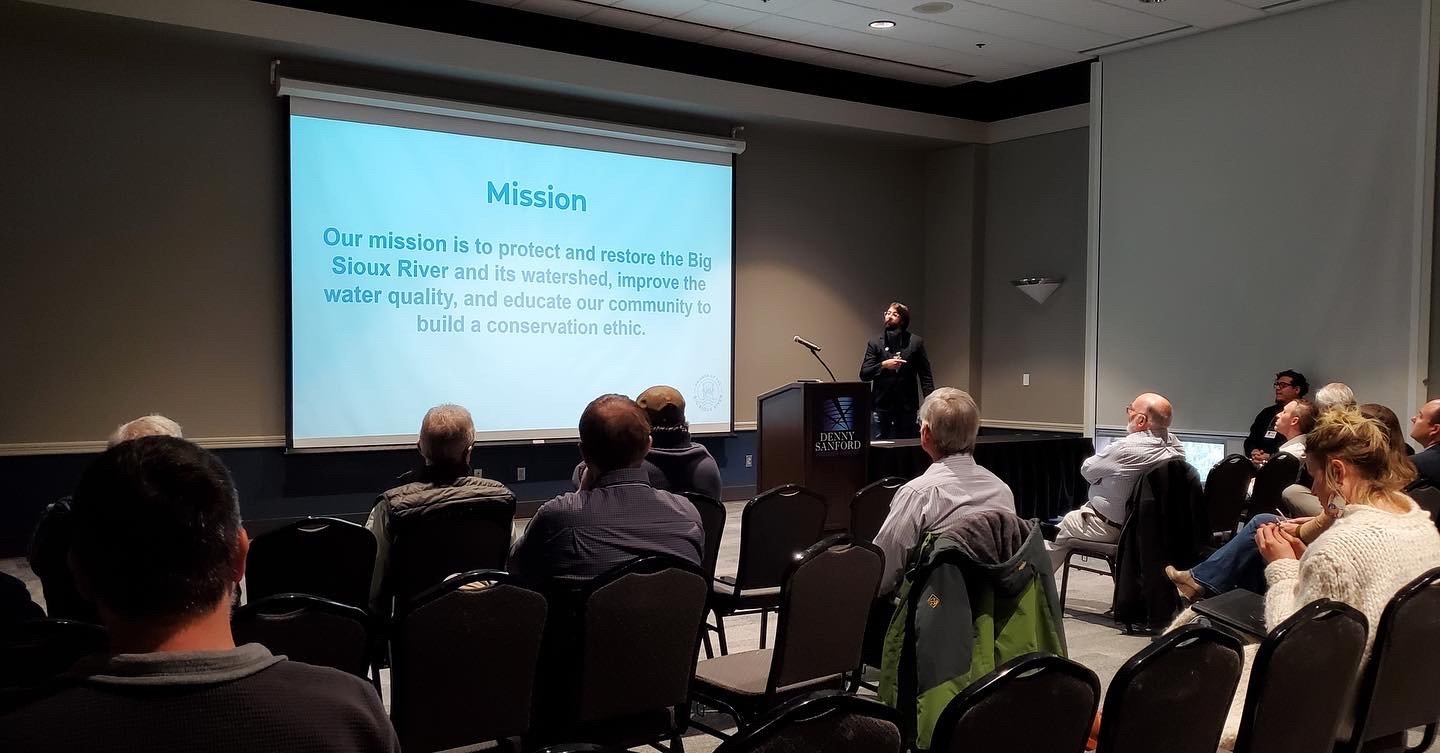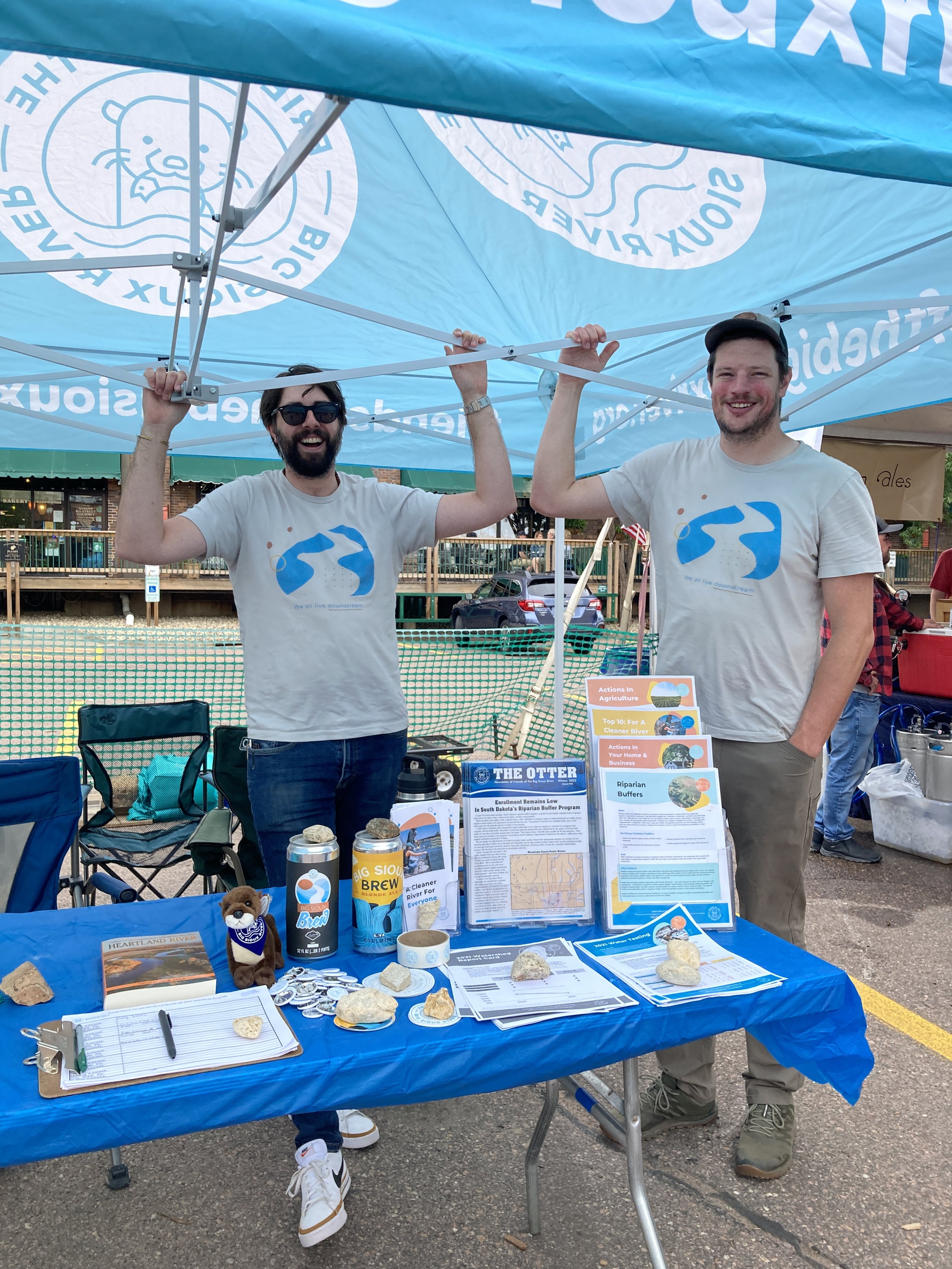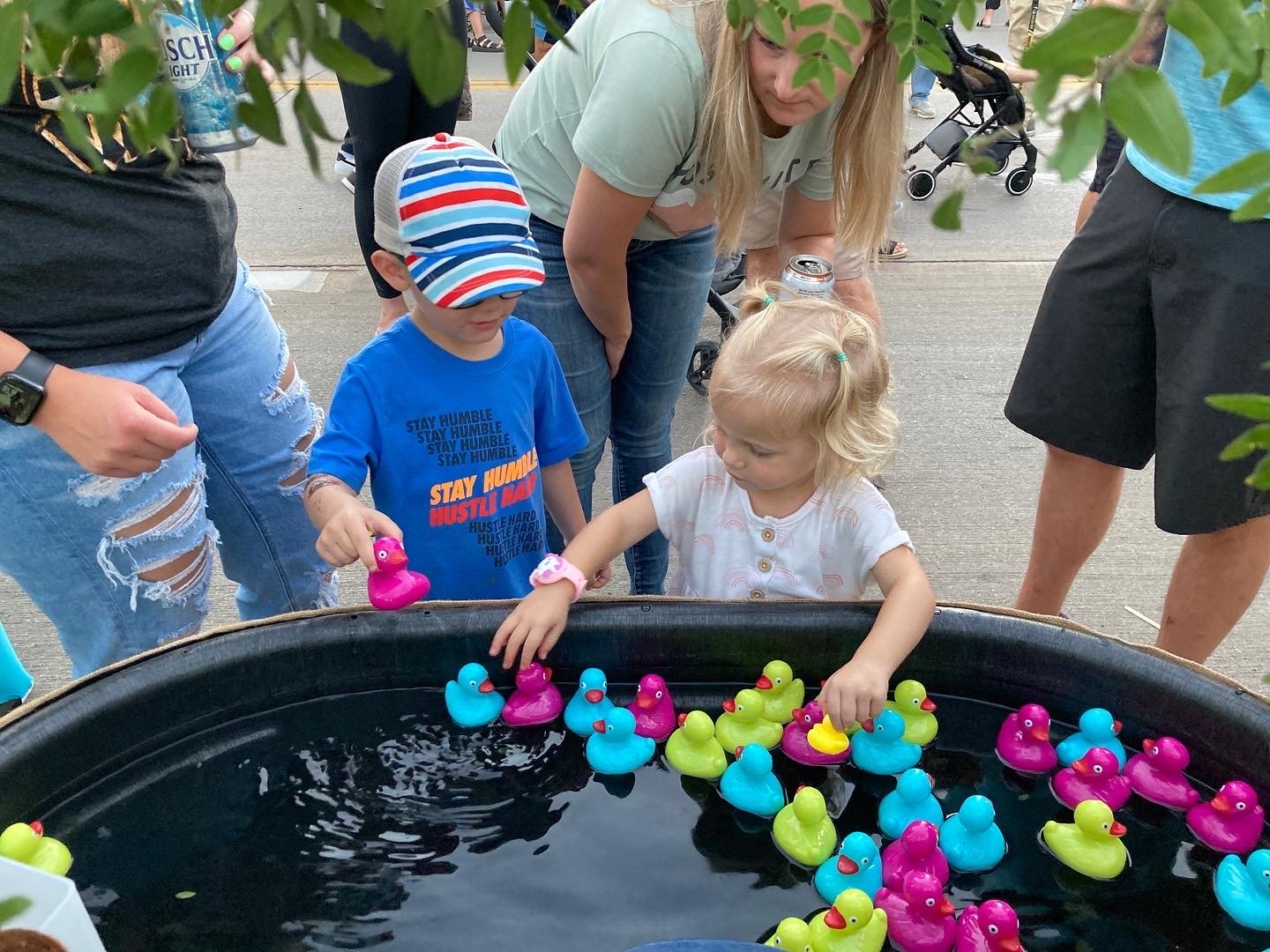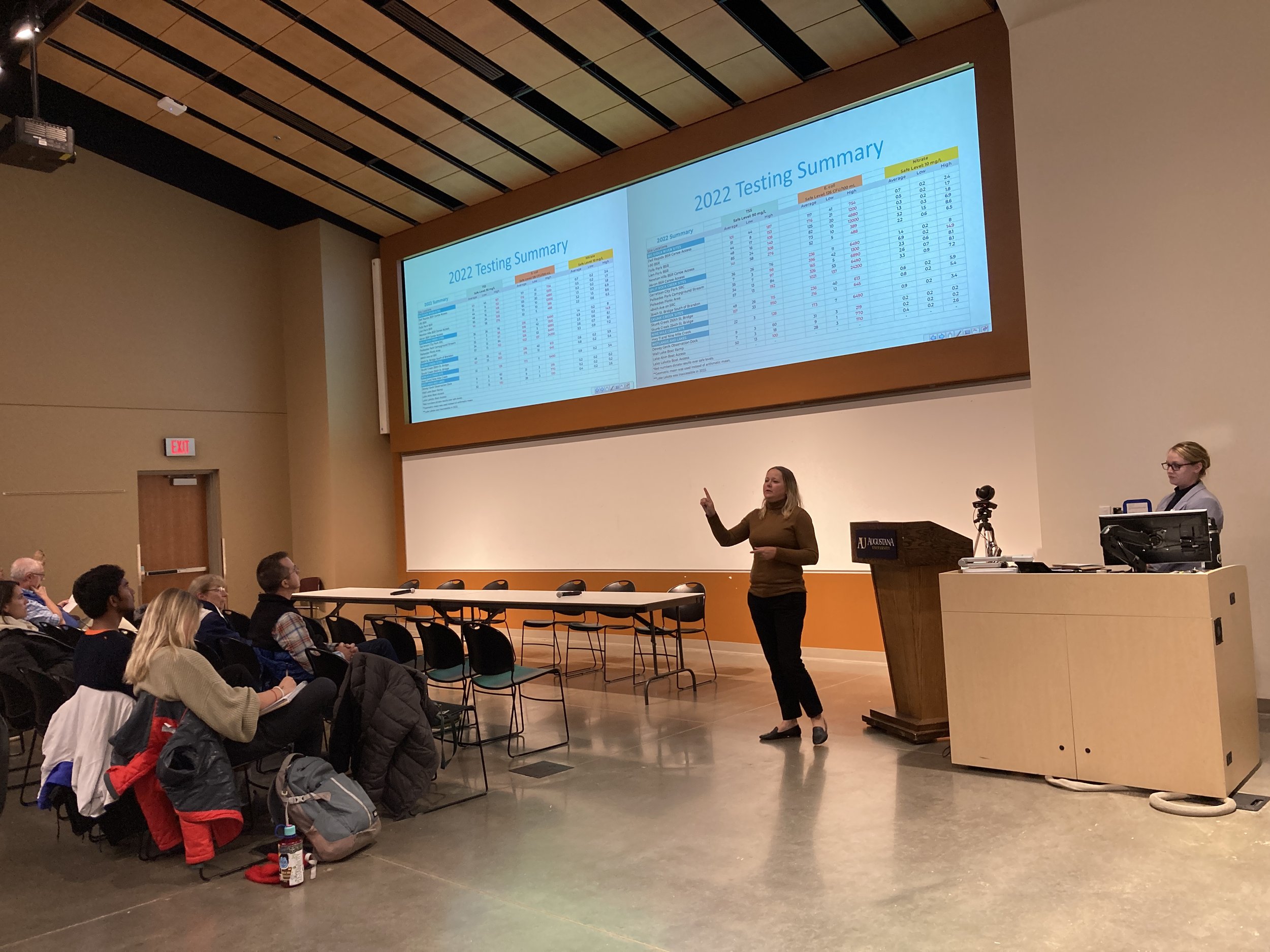
Education
Stormwater runoff, sewage contamination, trash, invasive plants, soil erosion, and uninformed daily actions are all problems that continue to plague the Big Sioux River, its watershed communities, and wildlife. People want to help, but often do not understand the issues completely or feel that they lack the power to make a difference.
Friends of the Big Sioux River works to offer an answer by engaging residents of all ages in meaningful education programs where participants learn about the issues through hands-on educational experiences and become part of an on-going effort to protect and restore the Big Sioux River and its watershed communities. Our goal is to increase awareness, knowledge, skills, and a sense of stewardship among watershed residents (youth to adult) that will result in changes in both present and future behavior, positively affecting the health of the river.
Interested in having FBSR present in your classroom or at your next organizational meeting? Contact Emily at outreach@friendsofthebigsiouxriver.org to learn more! We have information, lesson plans, and handouts for all ages, from K-12 to adults.
Activities and Presentations
K-12 Activities
Friends of the Big Sioux River offers a variety of free hands-on activities for students of all ages to learn about the Big Sioux River. From in-classroom hands-on learning opportunities to immersive field experiences, there is something for everyone! We will work with you to create a custom lesson based on the needs of your students. Click on the plus signs below to read about each activity.
-
Activity Type: PowerPoint presentation with accompanying art project
Age Group: Elementary School
Class Size: Up to 50 students
Time: ~45 minutesIn this engaging presentation, students delve into the diverse ecosystem of a watershed, discovering the myriad animals that inhabit its waters and shores. Throughout the presentation, each student draws their own river scene on paper while learning about the various animals indigenous to the watershed, gaining insights into their habitats, behaviors, and roles within the ecosystem. By visualizing and illustrating these concepts, students not only enhance their artistic skills but also develop a heightened awareness of environmental issues affecting local wildlife and the importance of safeguarding water resources.
-
Activity Type: Field trip to a local waterbody
Age Group: Elementary School through High School
Class Size: Up to 25 students
Time: ~1-2 hoursIn this hands-on field trip, students explore a nearby waterbody to investigate aquatic macroinvertebrates, which include creatures like dragonfly nymphs, mayfly nymphs, aquatic worms, and others. These organisms serve as indicator species, offering insights into the water's pollution levels. The activity is adaptable for K-12 students, catering to different age groups with varying levels of involvement.
Elementary students remain on the water's edge, using dip nets to collect macroinvertebrates under the guidance of FBSR staff who assist in identification. Middle and high school students don waders to venture into the water, gathering macroinvertebrates by hand and with nets. Back on shore, students use dichotomous keys to classify and assess the bugs they gather. By analyzing the species present, students determine the waterbody's pollution status. FBSR supplies all necessary materials for this field exploration of local aquatic ecosystems.
-
Activity Type: Hands-On Activity
Age Group: Elementary School through Middle School
Class Size: Up to 25 students
Time: ~30 minutesWith this activity, students will build their own aquifer in a cup to learn how water is stored in an aquifer and how groundwater can become contaminated. Each student constructs a miniature aquifer inside a clear plastic cup, layering sand, modeling clay, and aquarium gravel to simulate different geological layers. They observe how water behaves differently in each layer. By adding food coloring to simulate pollutants, students see how contaminants can spread through groundwater. Students will leave with a clear understanding of how careless use and disposal of harmful contaminants above the ground can potentially end up in the drinking water below the ground.
-
Activity Type: Hands-on activity with optional PowerPoint
Age Group: Middle School through High School
Class Size: Up to 25 students
Time: ~30 minutes for activity, ~1.5 hours with presentation and activityIn this activity, students analyze pre-collected water samples from five Big Sioux River locations around Sioux Falls. Students test the samples for pH, total dissolved solids, nitrates, ammonia, and nitrites. Based on their findings, students use the data to determine the water quality of the river. A PowerPoint presentation is available to accompany this activity for students to learn more about the water quality of the Big Sioux River.
This activity can also be modified into a field trip experience. During the field trip, students will collect the water samples at one or two locations along the Big Sioux River and analyze the samples directly in the field. This experience gives students an even greater hands-on approach to water quality sampling. FBSR will provide all of the materials to complete this activity.
-
Activity Type: Hands-on activity with optional PowerPoint and worksheet
Age Group: Elementary School through Middle School
Class Size: Up to 25 students
Time: ~30 minutes for activity, ~1 hour with presentation and activityIn this activity, students create a model watershed using a crumpled piece of paper and markers. After completing their model, they spray the paper to see where water flows when it rains. The activity is then repeated a second time. In experiment #2, students draw houses, farms, factories, and roads on their paper. This time, when it "rains," students see how people and communities can impact water quality. A PowerPoint and worksheet can be added to this activity depending on the age level and time allotment.
-
Activity Type: Hands-On Activity
Age Group: Elementary School through Middle School
Class Size: Up to 25 students
Time: ~15 minutesIn this activity, students will identify several sources of rock materials that make up an aquifer. Using funnels, gravel, sand, and clay, they will observe how water moves through each material and determine which material allows water to flow the fastest. This activity demonstrates the concept of aquifers and how the permeability of materials affects groundwater flow.
-
Activity Type: Hands-On Activity
Age Group: Upper Elementary School
Class Size: Up to 25 students
Time: ~30 minutes"The Journey of Barney the Bass" activity teaches students about water pollution and its effects on aquatic life. Students simulate Barney's journey downstream from a clean river to a polluted environment. They gradually introduce pollutants such as sediment, manure, fertilizers, weed killer, and litter into the water, illustrating how human activities can degrade aquatic habitats. Through role-playing and observation, students learn about the importance of clean water for aquatic ecosystems and explore ways to mitigate pollution and protect water resources. This hands-on approach engages students in understanding environmental issues and encourages them to consider their impact on water resources.
-
Activity Type: Hands-On Activity
Age Group: Elementary School through Middle School
Class Size: Up to 25 students
Time: ~30 minutesIn this activity, students engage in a hands-on exploration of water clarity and cleanliness. Students conduct basic experiments on jars filled with various substances, such as vinegar, tap water, and 7-Up, to investigate how appearances can be deceiving when assessing water quality. Throughout the activity, students discover that even seemingly clear water can harbor pollutants that are invisible to the naked eye. This educational approach not only enhances their scientific inquiry skills but also fosters an understanding of the complexities involved in assessing environmental health and safety.
-
Activity Type: Game
Age Group: Elementary School through Middle School
Class Size: Up to 30 students
Time: ~30 minutesIn this activity, students demonstrate the interconnectedness of water users in a community by building a water web. Each student receives a name tag with a different water user (e.g., dairy farmer, restaurant owner, wildlife, manufacturer, etc.) Students stand in a circle and describe the goods or services their water user provides and how their product or service uses water. One student is given a ball of yarn. Other students must raise their hands if they use the goods or services offered by that student. The ball of yarn is then tossed between students as they make connections between different water uses. For example, a restaurant owner may pass the yarn to a soda manufacturer because they use their goods in the restaurant. This game shows students how communities are connected by water and how it is up to all community members and businesses to conserve water to ensure there is enough for everyone.
-
Activity Type: Game that can be played in a gym or on a large field
Age Group: Elementary School
Class Size: Up to 30 students
Time: ~20 minutesIn this game, students pretend to be migrating waterbirds traveling between nesting habitats and wintering grounds. Carpet squares are placed on the ground to represent wetlands. On the teacher's signal, students "migrate," e.g., run between the wetland habitats, with 3-4 students allowed on one wetland at a time. If they can't find a wetland that isn't "full," their bird "passes away" and has to move to the sidelines. During each turn, a scenario is given that may or may not allow students to rejoin the game. Example scenarios include removing one habitat because a wetland was drained or adding one habitat because a farmer implemented a conservation practice on their land. The game demonstrates how wetland bird habitat availability is affected by environmental changes and human activities.
4-H and FFA Activities
-
The 4-H Soil and Water Science curriculum is for youth who enjoy learning about science and two important natural resources: soil and water.
Level 1 introduces basic terms and concepts. Activities focus on understanding important soil and water processes.
Level 2 activities help you put the basic concepts into action to understand more advanced soil and water concepts and interactions with the environment.
Level 3 activities are divided into chapters based on how you might use the information you have learned — as a homeowner, resident of a watershed, food and fiber producer (farmer), mayor, teacher, or legislator. Level 3 delves deeper into soil and water science concepts and can prepare you to be well informed and to study these topics at a college or university.
-
This 124-page youth text and workbook teaches middle school-age children about habitats as part of a three-year course. An ongoing narrative involving the characters Emily and Logan (peer examples) helps guide youth to develop a sense of responsibility about habitat maintenance as they participate in multiple experiential, interactive and supervised learning activities (worksheets included). Topics covered include soil science, watersheds, how to determine water quantity and quality, assessing habitat health, monitoring water use and more. A handy glossary helps refresh students’ understanding of key terms.
-
Water Wizards teaches 4th-6th grade students about water and its importance to the planet. Students participate in hands-on learning experiences that encourage inquiry, teach basic information about water, and develop awareness about this valuable resource. They explore the water cycle, watersheds and pollution; study water usage in their home; and conduct experiments exploring salinity, density, hardness and taste (Is bottled water really better?). Youth also take action on a water issue in their community. The program balances the need for critical information about water with discovery through the process of doing science. It also empowers kids to know they can make a difference in their communities.
-
This water conservation and water quality curriculum is grounded in a simple yet powerful concept that water is a finite natural resource whose quantity and quality must be responsibly preserved, protected, used, and reused.
The curriculum includes six sequential learning modules and is intended for delivery in out-of-school group settings to be facilitated by an adult. -
Developed by Penn State Extension, Rain to Drain - Slow the Flow is a hands-on stormwater education curriculum. This experiment style series of activities leads youth and adults to a better understanding of the movement of stormwater in natural and developed communities. It's also a great introduction to green infrastructure and stormwater best management practices.
This curriculum is designed to be used by middle-school aged youth; it is also easily adaptable to older and younger youth and also for adults. -
We are happy to present on any of the following FFA Natural Resources Curriculum materials:
Friends of the Big Sioux River offers 4-H and FFA lessons for students of all ages. We will work with you to create a custom lesson based on the needs of your students. We have access to the following 4-H and FFA resources and curriculum books. Click on the plus signs below to learn more.
Presentations
Friends of the Big Sioux River offers a number of presentations for middle school, high school, college, and community groups. Our two most popular presentations center around water quality and water quantity in the Big Sioux River watershed. We will also work with you to create a custom presentation based on the needs of your students or community group. Click on the plus signs below to learn more.
-
Our water quality presentation covers the following topics:
Water quality basics
Watershed basics
Common contaminants
Water quality in the Big Sioux River watershed
How to improve water quality in urban and rural areas
This presentation lasts for approximately 45 minutes, but it can be adjusted to fit your time needs.
-
Our water quantity presentation covers the following topics:
Water quantity basics
Precipitation and drought trends
Water use statistics
The future of water in South Dakota
How to save water in urban and rural areas
This presentation lasts for approximately 45 minutes, but it can be adjusted to fit your time needs.
-
FBSR will create a custom presentation to fit the needs of your students or community group. Topics we can cover include:
Water quality basics
Water quantity basics
Watershed basics
Common contaminants
Water quality in the Big Sioux River watershed
How the Big Sioux River contributes to the Dead Zone
How to improve water quality in urban and rural areas
Precipitation and drought trends
Water use statistics/trivia
The future of water in South Dakota
How to save water in urban and rural areas
Are you ready to have FBSR visit your classroom or community group?
Contact Emily at outreach@friendsofthebigsiouxriver.org to schedule your customized presentation or hands-on learning opportunity today!
Education Handouts
Learn more about actions you can take in your community to improve water quality by downloading our educational handouts below.
FBSR Education in Action
